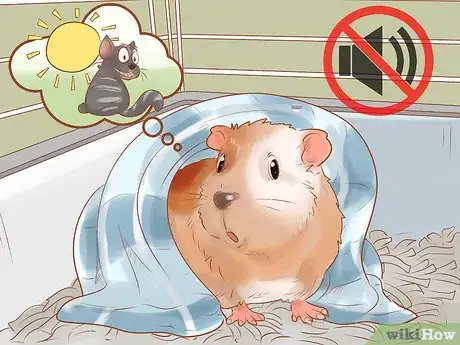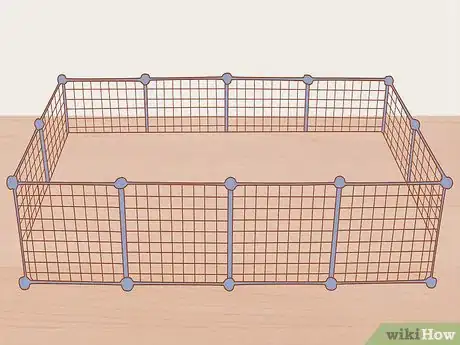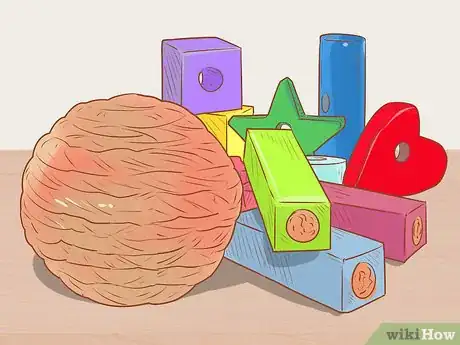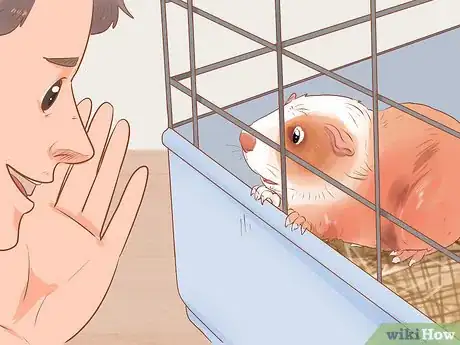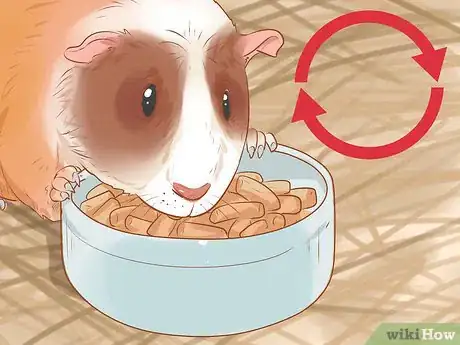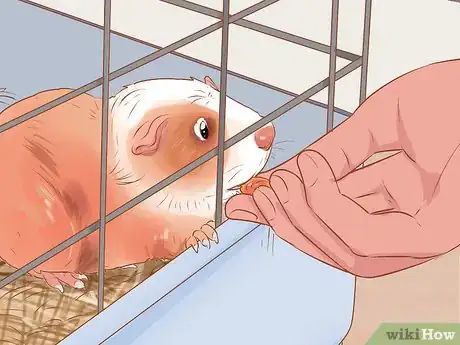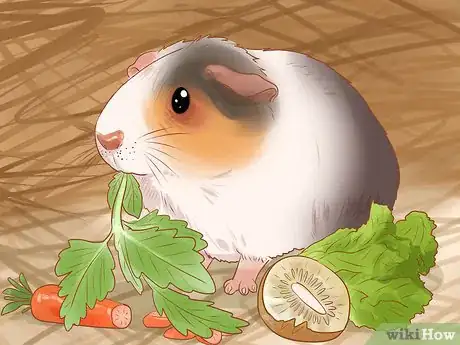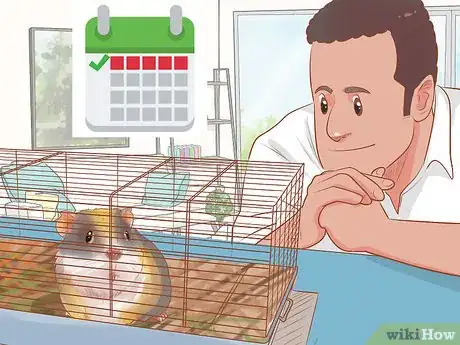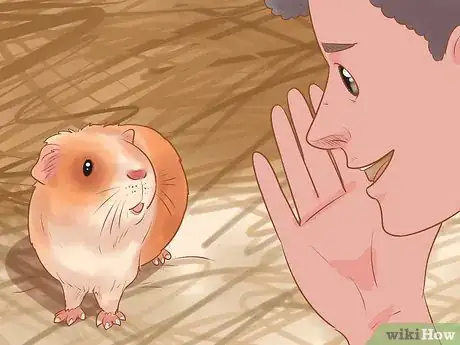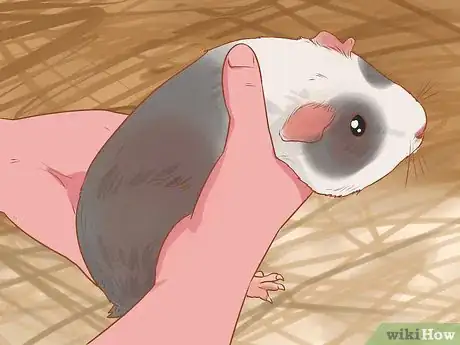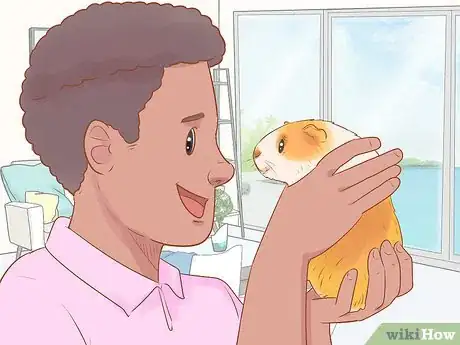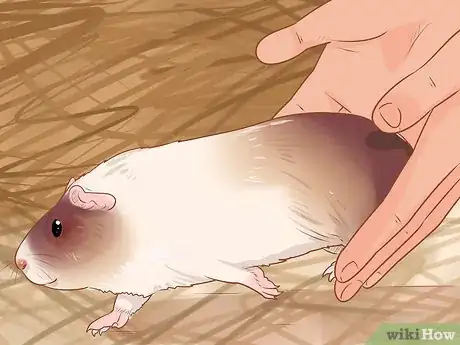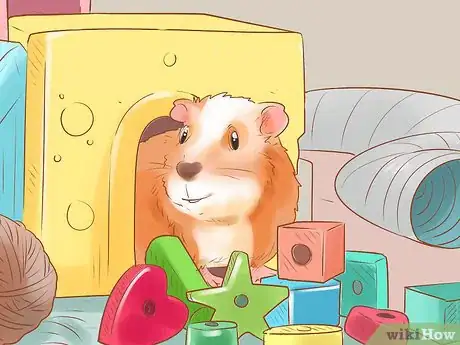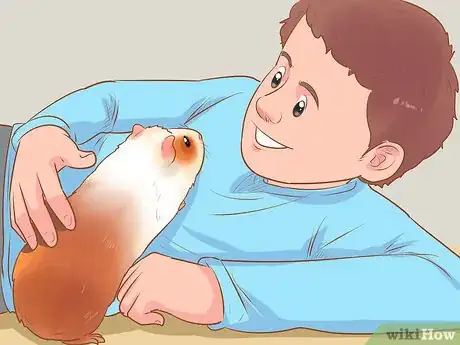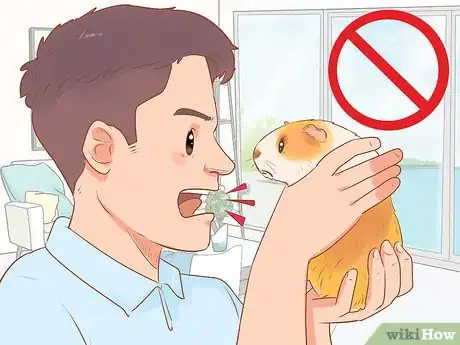This article was co-authored by Pippa Elliott, MRCVS. Dr. Elliott, BVMS, MRCVS is a veterinarian with over 30 years of experience in veterinary surgery and companion animal practice. She graduated from the University of Glasgow in 1987 with a degree in veterinary medicine and surgery. She has worked at the same animal clinic in her hometown for over 20 years.
There are 8 references cited in this article, which can be found at the bottom of the page.
wikiHow marks an article as reader-approved once it receives enough positive feedback. In this case, 85% of readers who voted found the article helpful, earning it our reader-approved status.
This article has been viewed 109,538 times.
Guinea pigs are known for being affectionate, gentle pets. However, it may take time for your guinea pig to feel comfortable in your presence and to build a bond with you. Providing a safe place and talking to your new pet will help them to feel secure. Playing with your guinea pigs, and handling them correctly will help your guinea pig to begin to trust you. From there, you can build a strong bond with your new, adorable pet.
Steps
Creating a Comforting Environment
-
1Choose a quiet, calm location for your guinea pig’s cage. When your guinea pig first arrives in your home, it is likely to be overwhelmed and scared. A secure, calm, and quiet space will help your guinea pig begin to feel safe in its new environment.[1]
- Keep your guinea pig away from other pets, small children, and loud noises. A quiet space will help to prevent the guinea pig from becoming startled or scared.
- If possible, place your guinea pig’s cage in a room that can be completely shut off. This way you can occasionally open the cage and let your guinea pig have playtime.
- Give your guinea pig some time to adjust to its new home. Avoid handling it for up to 3 days after you bring it home to help it settle in.
-
2Buy a cage that is large enough for your guinea pig. The minimum recommended cage size for 1-2 guinea pigs is 7.5 square feet (2.3 m). Add 1.5 square feet (.46m) for each additional guinea pig. There should be plenty of room for the guinea pig to run; if you add a lot of ramps or accessories, you may need to go to a larger size.
- The base of the cage should be a solid surface. Guinea pigs may get their paws stuck and injure themselves if the floor of the cage is made of wire or mesh. A solid plastic floor is safer and will be easy to clean. That said, no matter what type of cage you get, you will need a thick layer of bedding to protect your guinea pig's feet.
- Look for cages that are easy to clean and maintain. You should be able to easily reach all areas of the cage. You should also look for cages made from easily cleanable materials, such as plastic. Metal cages are also acceptable, but be aware that they may rust and need to be replaced.
Advertisement -
3Add bedding to the cage. Hay, paper, towels, and woodchips can all serve as bedding for your guinea pig. Most pet stores sell wood shavings which are also a popular form of bedding. Remember to change the bedding about once every week.[2]
- Never add damp or wet bedding as it can grow mold. Avoid using sawdust or straw as bedding as they can also mold easily.
- Cedar and pine shavings can be toxic to guinea pigs, so look carefully at the type of wood shavings you are using as bedding.
-
4Place toys and hutches into the cage. These will help the guinea pig to feel comfortable. Huts and igloos provide a place where the guinea pig can hide and feel safe when they are overwhelmed. They can be purchased online or at your local pet store.[3]
- Consider adding toys, such as balls, ramps, or cardboard tubes to provide entertainment for your guinea pig.
-
5Talk to your guinea pig. Speaking to your guinea pig will help them get used to your voice. When you feed them, clean the cage, or change their water, talk to them in a calm tone. You should also visit your guinea pig and speak to them throughout the day so that they begin to get used to your presence.[4]
Using Food For Bonding
-
1Be consistent about your guinea pig’s feeding schedule. Set up a routine for feeding your guinea pig. Try to feed them at the same times in the day. Also, try to feed them in a place they feel safe, such as their cage or play area.[5]
- A consistent schedule will mean that your guinea pig begins to associate you with food; this is key to forming a bond with your guinea pig.
- Remember that whoever feeds the guinea pig will likely be the person they bond with first. If multiple people are going to oversee feeding, give them an assigned time. You can feed them in the morning, and your daughter in the evening. Or feed the guinea pig together so it gets used to both of you.
-
2Use hand feeding to develop a sense of trust. The goal of using snacks is to have the guinea pig associate you with food. This is a positive association that will help the guinea pig to feel comfortable around you.[6]
- At first, just place the treats in the cage. Then after a few days, hold it in your hand and see if the guinea pig will come closer to you. If they won’t come all the way, toss the food gently in their direction.
- Have the guinea come closer each time you offer snacks. Eventually, it will begin to take it out of your hand and will begin to feel less nervous around you.
- Make sure you are talking in a calm yet happy voice as you feed them.
-
3Treat your guinea pigs to healthy snacks. Grass, vegetables, and some fruit are all tasty treats for your guinea pig. Try foods such as cucumber, carrots, banana slices, romaine lettuce, and seedless apples.[7]
- Pet stores also sell treats marketed for guinea pigs and other small animals. Make sure you read the labels first; some have a lot of high fructose corn syrup and are full of empty calories.
- Give all treats in moderation. Too much sugar, empty calories, or just overfeeding can cause your guinea pig to become obese. This can have serious health complications for your pet and may shorten its lifespan.
Handling Your Guinea Pig Correctly
-
1Keep handling of your guinea pig to a minimum for the first week. It will be very tempting to try to pick up, cuddle, or play with your new pet, but this could further traumatize your guinea pig. It will also make it harder for you to build trust with the guinea pig.[8]
- For the few days, you should try to avoid touching the guinea pig at all. After that, try to start petting the guinea pig for increasingly longer periods.
- Be patient and don’t handle your guinea pig until they seem comfortable with you. If they still don’t let you pet them, then they are not ready to be picked up. It could take several weeks or months to make the guinea pig comfortable enough to be handled so try not to rush it.
-
2Give your guinea pig plenty of warning before picking them up. Guinea pigs are prey animals and are easily spooked by sudden movements. They also have poor eyesight so try not to sneak up on them.[9]
- Talking in a soothing voice will help the guinea pig to recognize your presence.
- Try not to approach the guinea pig from behind. Let them see you, and approach slowly. Quick movements will scare them.
-
3Avoid grabbing your guinea pig from above. If their cage is on the floor, sit down on the ground. If it is on a table, then stoop to its level. Picking up the guinea pig from above might cause it to associate you with a predator.
-
4Carry guinea pigs with both hands. Support their back end with one hand, and place the other hand on top of their shoulders to prevent them from jumping. Grip them securely but not too tightly, and hold them close to your body so they don’t feel like they will fall. Holding them correctly will help them to feel safe when you pick them up.[10]
- When you first start picking up your guinea pig, hold them from a seating position. Being carried while walking may make the guinea pig nervous as they fear the height.
- Carefully monitor children as they handle the guinea pig. Show them the correct hold and make sure they are gentle and don’t get overly excited.
- Consider using a blanket to carry your guinea pig. Wrapping your guinea pig in a blanket makes them feel more secure as they are carried.
-
5Play with your guinea pigs for at least half an hour per day. Interacting with your guinea pig is essential to creating a bond with them. Handling and petting your guinea pigs are important forms of interaction, but the play is a great way for you to bond with your guinea pig.[11]
-
6Give guinea pigs the chance to explore outside of their cages. If you have a room that can be completely shut off, then let them loose to explore. If there are no rooms available, create a playpen by using mesh or boxes. Just be careful that the guinea pig can’t chew through the playpen walls.[12]
-
7Create a play area for your guinea pig. This area should include boxes, balls, ramps, and cardboard paper towel tubes. Sit in or near the area and talk to your guinea pig as they play. Offer them treats, or move the ball for them to chase. Associating you with play Is an effective method for bonding with your guinea pig. And the more time they spend in your presence, the more comfortable they will be with you.[13]
-
8Lay down in the play area and let the guinea pig investigate you. Although guinea pigs can be nervous, they are also very curious. If you lay still, and cover your face, they will probably come over to sniff or climb on you. This is a great way to have fun and bond with your guinea pig.[14]
-
9Never shout at your guinea pig. They will not understand why you are shouting and will become frightened. Shouting or punishing your guinea pig can also cause them to become scared of you and will hinder the bonding process. You should also never punish your guinea pig by withholding food, treats, or toys. They will not understand why this is occurring, and it will hurt your relationship with your guinea pig.[15]
Warnings
- "Over handling" is possible. Don't constantly have your guinea pig out of the cage. Over handling can lead to stress and make your pig sick or cause them to be nervous in your presence.⧼thumbs_response⧽
References
- ↑ http://www.calicavycollective.com/2015/11/7-tips-bonding-with-your-guinea-pig.html
- ↑ http://www.guineapigmanual.com/guinea-pig-bedding/
- ↑ http://www.guineapigmanual.com/guinea-pig-cages/
- ↑ http://animals.mom.me/quick-easy-ways-guinea-pigs-like-6095.html
- ↑ http://www.guineapigtricks.com/taming--bonding.html
- ↑ http://www.guineapigtricks.com/taming--bonding.html
- ↑ https://www.petful.com/other-pets/make-guinea-pig-love/
- ↑ http://www.guineapigtricks.com/taming--bonding.html
- ↑ http://www.guineapigtricks.com/taming--bonding.html
- ↑ https://www.petful.com/other-pets/make-guinea-pig-love/
- ↑ http://animals.mom.me/quick-easy-ways-guinea-pigs-like-6095.html
- ↑ http://animals.mom.me/quick-easy-ways-guinea-pigs-like-6095.html
- ↑ https://pethelpful.com/rodents/Three-Games-To-Play-With-Your-Guinea-Pigs
- ↑ https://pethelpful.com/rodents/Three-Games-To-Play-With-Your-Guinea-Pigs
- ↑ http://www.cavyspirit.com/biting.htm
About This Article
To bond with your guinea pig, talk to it when you’re doing things like feeding it, changing its water, and cleaning its cage, so it can get used to your voice. Additionally, hand-feed it treats between meals, since guinea pigs bond with the person who feeds them. You should also create a play area for your pet by setting up boxes, ramps, and cardboard paper towel tubes. Then, play with your guinea pig for at least 30 minutes every day so your pet associates you with having fun. For more tips from our Veterinary co-author, like how to pick up and hold your guinea pig safely, read on!
